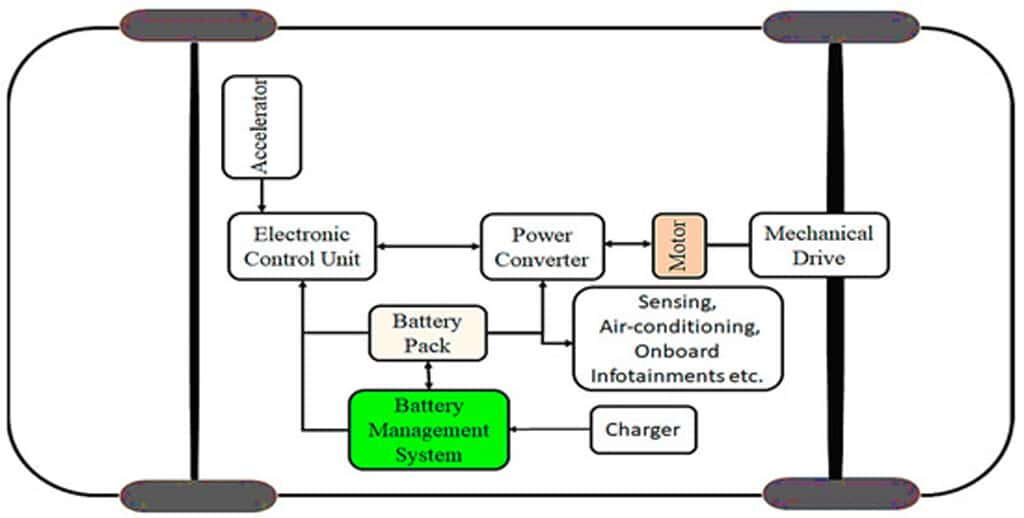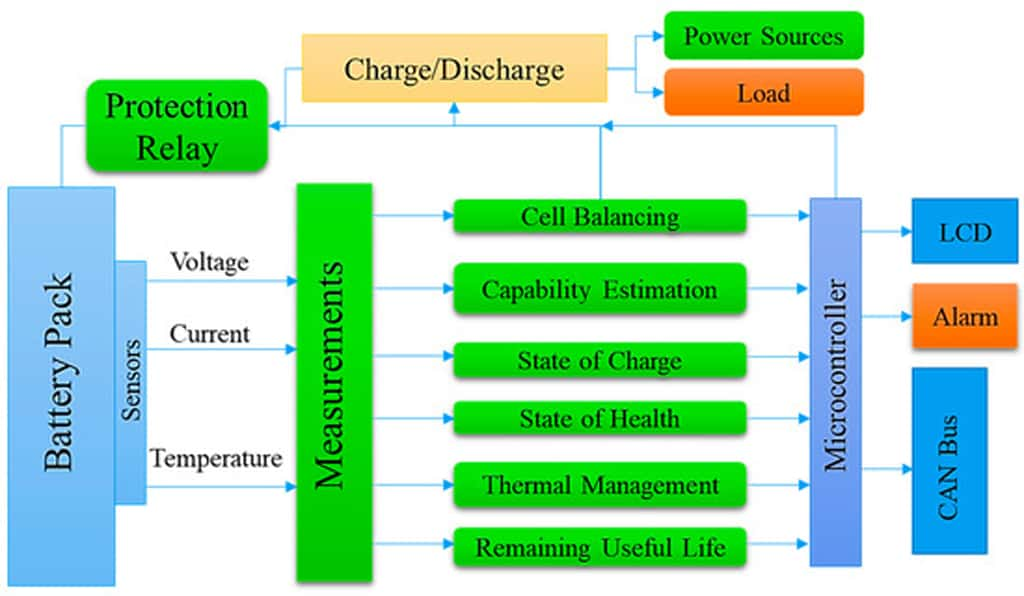When people talk about electric vehicles (EVs), the conversation often revolves around range, acceleration, and charging speed. However, behind this dazzling performance, a quiet yet crucial component is hard at work: the EV Battery Management System (BMS).
You can think of the BMS as a highly diligent "battery guardian." It not only keeps an eye on the battery's "temperature" and "stamina" (voltage) but also ensures every member of the team (the cells) works in harmony. As a report from the U.S. Department of Energy highlights, "advanced battery management is critical to advancing the adoption of electric vehicles."¹
We will take you on a deep dive into this unsung hero. We will start with the core it manages—the battery types—then move to its core functions, its brain-like architecture, and finally look toward a future driven by AI and wireless technology.
1: Understanding the BMS's "Heart": EV Battery Types
The design of a BMS is intrinsically linked to the type of battery it manages. Different chemical compositions demand vastly different management strategies. Understanding these batteries is the first step to grasping the complexity of BMS design.
Mainstream and Future-Trend EV Batteries: A Comparative Look
| Battery Type | Key Characteristics | Advantages | Disadvantages | BMS Management Focus |
|---|---|---|---|---|
| Lithium Iron Phosphate (LFP) | Cost-effective, very safe, long cycle life. | Excellent thermal stability, low risk of thermal runaway. Cycle life can exceed 3000 cycles. Low cost, no cobalt. | Relatively lower energy density. Poor performance in low temperatures.Difficult to estimate SOC. | High-precision SOC estimation: Requires complex algorithms to handle the flat voltage curve.Low-temperature preheating: Needs a powerful integrated battery heating system. |
| Nickel Manganese Cobalt (NMC/NCA) | High energy density, long driving range. | Leading energy density for longer range. Better performance in cold weather. | Lower thermal stability. igher cost due to cobalt and nickel.Cycle life is typically shorter than LFP. | Active safety monitoring: Millisecond-level monitoring of cell voltage and temperature.Powerful active balancing: Maintains consistency among high-energy-density cells.Tight thermal management coordination. |
| Solid-State Battery | Uses a solid electrolyte, seen as the next generation. | Ultimate safety: Fundamentally eliminates the risk of fire from electrolyte leakage. Ultra-high energy density: Theoretically up to 500 Wh/kg.Wider operating temperature range. | Technology is not yet mature; high cost.Challenges with interface resistance and cycle life. | New sensing technologies: May need to monitor new physical quantities like pressure. Interface state estimation: Monitoring the health of the interface between the electrolyte and electrodes. |
2: The Core Functions of a BMS: What Does It Actually Do?

A fully functional BMS is like a multi-talented expert, simultaneously playing the roles of an accountant, a doctor, and a bodyguard. Its work can be broken down into four core functions.
1. State Estimation: The "Fuel Gauge" and "Health Report"
•State of Charge (SOC): This is what users care about most: "How much battery is left?" Accurate SOC estimation prevents range anxiety. For batteries like LFP with a flat voltage curve, accurately estimating SOC is a world-class technical challenge, requiring complex algorithms like the Kalman filter.
•State of Health (SOH): This assesses the battery's "health" compared to when it was new and is a key factor in determining the value of a used EV. A battery with an 80% SOH means its maximum capacity is only 80% of a new battery.
2. Cell Balancing: The Art of Teamwork
A battery pack is made of hundreds or thousands of cells connected in series and parallel. Due to tiny manufacturing differences, their charge and discharge rates will vary slightly. Without balancing, the cell with the lowest charge will determine the entire pack's discharge endpoint, while the cell with the highest charge will determine the charging endpoint.
•Passive Balancing: Burns off excess energy from higher-charged cells using a resistor. It's simple and cheap but generates heat and wastes energy.
•Active Balancing: Transfers energy from higher-charged cells to lower-charged cells. It's efficient and can increase usable range but is complex and costly. Research from SAE International suggests active balancing can increase a pack's usable capacity by about 10%⁶.
3. Safety Protection: The Vigilant "Guardian"
This is the most critical responsibility of the BMS. It continuously monitors the battery's parameters through sensors.
•Over-Voltage/Under-Voltage Protection: Prevents overcharging or over-discharging, the main causes of permanent battery damage.
•Over-Current Protection: Quickly cuts off the circuit during abnormal current events, such as a short circuit.
•Over-Temperature Protection: Batteries are extremely sensitive to temperature. The BMS monitors temperature, limits power if it's too high or low, and activates heating or cooling systems. Preventing thermal runaway is its top priority, which is vital for a comprehensive EV Charging Station Design.
3.The BMS's Brain: How Is It Architected?

Choosing the right BMS architecture is a trade-off between cost, reliability, and flexibility.
BMS Architecture Comparison: Centralized vs. Distributed vs. Modular
| Architecture | Structure & Characteristics | Advantages | Disadvantages | Representative Suppliers/Tech |
|---|---|---|---|---|
| Centralized | All cell sensing wires connect directly to one central controller. | Low cost Simple structure | Single point of failure Complex wiring, heavy Poor scalability | Texas Instruments (TI), Infineon offer highly integrated single-chip solutions. |
| Distributed | Each battery module has its own slave controller reporting to a master controller. | High reliability Strong scalability Easy to maintain | High cost System complexity | Analog Devices (ADI)'s wireless BMS (wBMS) is a leader in this field. NXP also offers robust solutions. |
| Modular | A hybrid approach between the other two, balancing cost and performance. | Good balance Flexible design | No single outstanding feature; average in all aspects. | Tier 1 suppliers like Marelli and Preh offer such custom solutions. |
A distributed architecture, especially wireless BMS (wBMS), is becoming the industry trend. It eliminates complex communication wiring between controllers, which not only reduces weight and cost but also provides unprecedented flexibility in battery pack design and simplifies integration with Electric Vehicle Supply Equipment (EVSE).
4: The Future of BMS: Next-Generation Technology Trends
BMS technology is far from its endpoint; it's evolving to be smarter and more connected.
•AI and Machine Learning: Future BMS will no longer rely on fixed mathematical models. Instead, they will use AI and machine learning to analyze massive amounts of historical data to more accurately predict SOH and Remaining Useful Life (RUL), and even provide early warnings for potential faults⁹.
•Cloud-Connected BMS: By uploading data to the cloud, it's possible to achieve remote monitoring and diagnostics for vehicle batteries worldwide. This not only allows for Over-the-Air (OTA) updates to the BMS algorithm but also provides invaluable data for next-generation battery research. This vehicle-to-cloud concept also lays the foundation for v2g (Vehicle-to-Grid) technology.
•Adapting to New Battery Technologies: Whether it's solid-state batteries or Flow Battery & LDES Core Technologies, these emerging technologies will require entirely new BMS management strategies and sensing technologies.
The Engineer's Design Checklist
For engineers involved in BMS design or selection, the following points are key considerations:
•Functional Safety Level (ASIL): Does it comply with the ISO 26262 standard? For a critical safety component like a BMS, ASIL-C or ASIL-D is typically required¹⁰.
•Accuracy Requirements: The measurement accuracy of voltage, current, and temperature directly impacts the accuracy of SOC/SOH estimation.
•Communication Protocols: Does it support mainstream automotive bus protocols like CAN and LIN, and does it comply with the communication requirements of EV Charging Standards?
•Balancing Capability: Is it active or passive balancing? What is the balancing current? Can it meet the design requirements of the battery pack?
•Scalability: Can the solution be easily adapted to different battery pack platforms with varying capacities and voltage levels?
The Evolving Brain of the Electric Vehicle
The EV Battery Management System (BMS) is an indispensable piece of the modern electric vehicle technology puzzle. It has evolved from a simple monitor into a complex embedded system that integrates sensing, computation, control, and communication.
As battery technology itself and cutting-edge fields like AI and wireless communication continue to advance, the BMS will become even more intelligent, reliable, and efficient. It is not only the guardian of vehicle safety but also the key to unlocking the full potential of batteries and enabling a more sustainable transportation future.
FAQ
Q: What is an EV Battery Management System?
A: An EV Battery Management System (BMS) is the "electronic brain" and "guardian" of an electric vehicle's battery pack. It's a sophisticated system of hardware and software that constantly monitors and manages every individual battery cell, ensuring the battery operates safely and efficiently under all conditions.
Q: What are the main functions of a BMS?
A: The core functions of a BMS include: 1) State Estimation: Accurately calculating the battery's remaining charge (State of Charge - SOC) and its overall health (State of Health - SOH). 2) Cell Balancing: Ensuring all cells in the pack have a uniform charge level to prevent individual cells from being overcharged or over-discharged. 3) Safety Protection: Cutting off the circuit in case of over-voltage, under-voltage, over-current, or over-temperature conditions to prevent dangerous events like thermal runaway.
Q: Why is a BMS so important?
A: The BMS directly determines an electric vehicle's safety, range, and battery lifespan. Without a BMS, an expensive battery pack could be ruined by cell imbalances within months or even catch fire. An advanced BMS is the cornerstone of achieving long range, long life, and high safety.
Post time: Jul-18-2025


